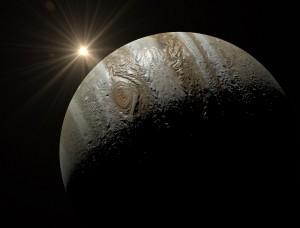Astronomers using NASA’s Hubble Space Telescope has captured an image of what may be water vapor plumes erupting off the surface of Jupiter’s moon Europa.
Europa’s ocean might be able to harbor life in the solar system, and the plumes, should they exist, could provide scientists a way to understand and sample Europa’s subsurface.
The plumes themselves are estimated to rise about 125 miles (200 kilometers) before, presumably, raining material back down onto Europa’s surface. Europa’s ocean has twice as much water as Earth’s oceans, but is covered with a layer of hard, thick ice of an unknown thickness. NASA astronomers’ finding provides support for other Hubble observations implicating that the icy moon may erupt with high altitude water vapor plumes, and increases the possibility that missions to Europa could sample the ocean without the need to drill through miles of ice.
Astronomers detected finger-like projections while viewing Europa’s limb as the moon passed in front of Jupiter. With the use of the same observing method that detects atmospheres around planets orbiting other stars, the team started looking for signs of water vapor, around the limb of Europa as it transcended the smooth face of Jupiter.
In 10 separate occurrences over a total span of 15 months, the scientists observed Europa passing in front of Jupiter and spotted what could be plumes erupting on three of these occasions.
The work thus far have suggested the plumes could be highly variable, essentially erupting sporadically at certain times and then dying down.
If confirmed, Europa would be the second moon in the solar system known to have water vapor plumes; the other is Saturn’s moon Enceladus.
For more information, please visit: www.nasa.gov

